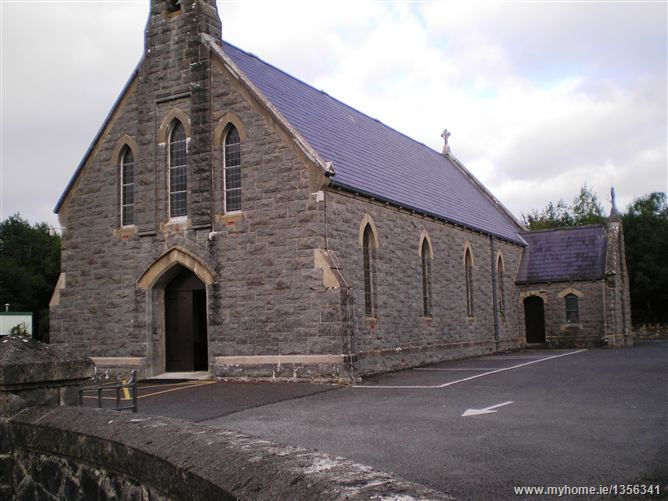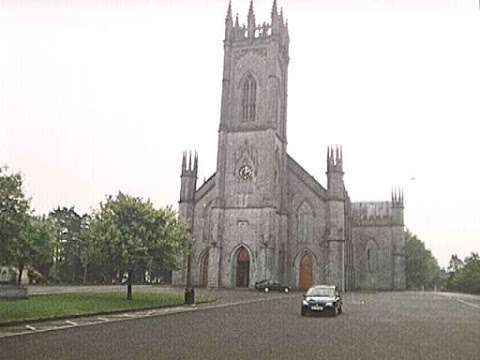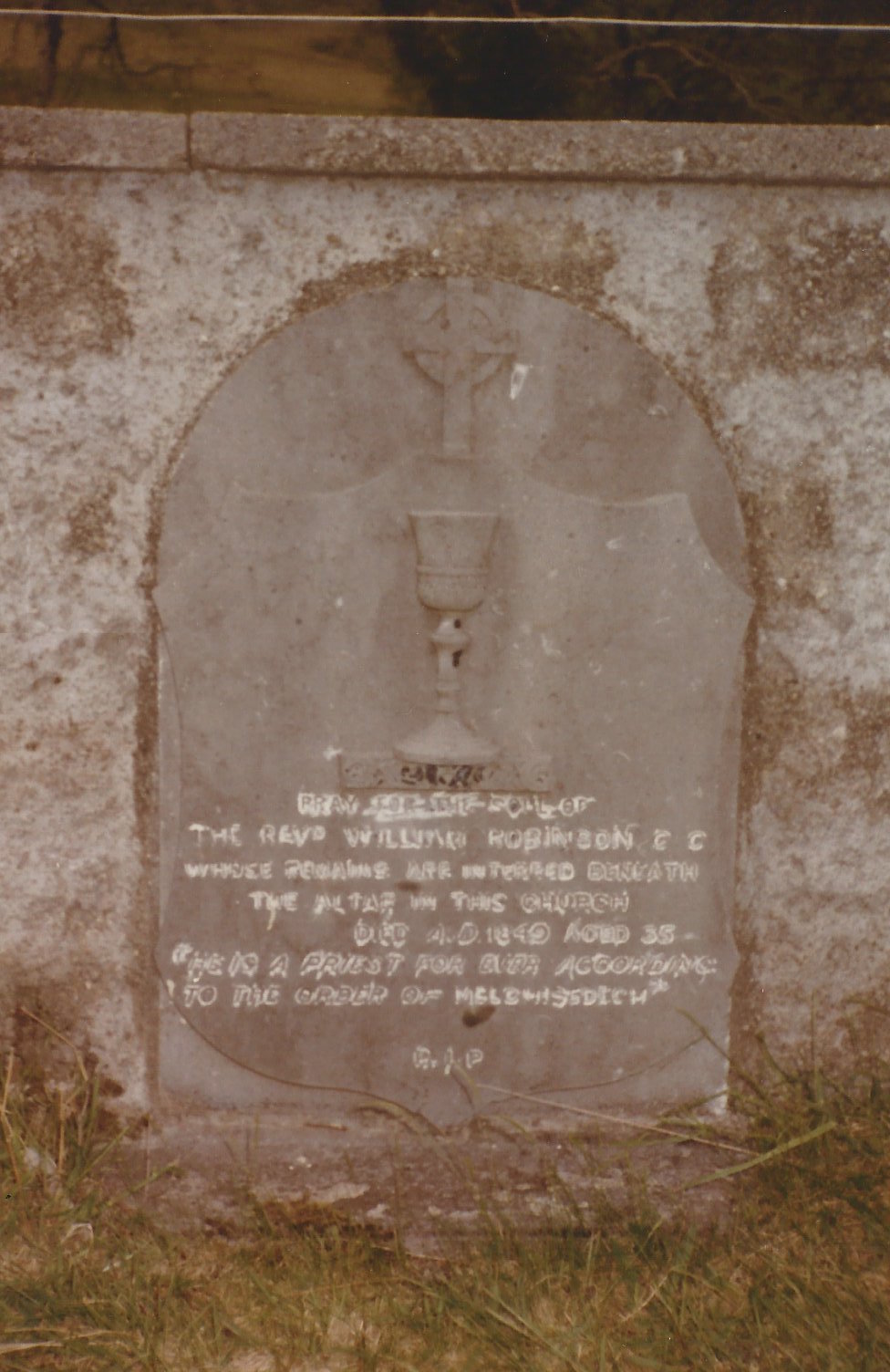My trip to Ireland was sparked off by the discovery of my great-great-great grandfather’s obituary in a microfilmed copy of the Daily Picayune newspaper in the New Orleans Public Library, dated Saturday morning, January 16, 1875, page 4, column 5.
On Thursday, January 14, 1875 at a quarter past 10 o’clock p.m., at the residence of Thos. M. Gilmore, corner of Victory and Mandeville streets. James Robinson, aged about forty-seven years, a native of parish of Annadown, County Galway, Ireland, and a resident of parish of Plaquemines.
The funeral will take place at 10 o’clock a.m., Saturday, January 16, from Mr. Gilmore’s residence, to steamboat J.F. Frazer, for final interment in Plaquemines parish. His friends and acquaintances are respectfully invited to attend.
New York Herald and Tuam (Galway) News please copy.
 There was no doubt that this was my ancestor Robinson. Supporting research in Plaquemines Parish, Louisiana proved it. Before I had done this research, the stories my grandfather told us about our Irish roots were just that - stories. My mother did not even believe we were Irish because the name Robinson was an English one.
There was no doubt that this was my ancestor Robinson. Supporting research in Plaquemines Parish, Louisiana proved it. Before I had done this research, the stories my grandfather told us about our Irish roots were just that - stories. My mother did not even believe we were Irish because the name Robinson was an English one.

My grandfather did not really even know from where in Ireland the Robinsons came. I had never doubted that we were Irish because my grandfather believed it so strongly. The tales of being descended from King Robin of Ireland were firmly etched in my mind as a child. But here was the first real evidence. And now we knew the exact places they came from. But names like Annadown, Galway, and Tuam were still just names.

Since I was living in London in the spring of 1986, it was no difficult problem to get to Ireland but I had put it off until the end of my stay. So unfortunately I had only one week to discover my Irish roots and I was going to have to do everything very fast. My first stopping place was where it was for most Irish genealogical researchers – the National Library in Dublin.
 At the National Library, I looked first at the Roman Catholic records for the parish of Annaghdown (pron. ANNA-down) that were on microfilm for the years 1834 to 1880. I assumed that the Robinsons of Ireland were Catholic since the Robinsons of America were Catholic. I looked at every marriage and baptism from the year 1834 through the year 1868 recorded in Annaghdown Parish and could find no mention of the name Robinson.
At the National Library, I looked first at the Roman Catholic records for the parish of Annaghdown (pron. ANNA-down) that were on microfilm for the years 1834 to 1880. I assumed that the Robinsons of Ireland were Catholic since the Robinsons of America were Catholic. I looked at every marriage and baptism from the year 1834 through the year 1868 recorded in Annaghdown Parish and could find no mention of the name Robinson.

It was sometimes difficult to read the original script, especially on microfilm, but I did not see any name that even resembled Robinson among the thousands of spouses, parents, sponsors, and witnesses. Nevertheless, it was fascinating to see the records become very chaotic around the start of the famine years (1845-49) and remain that way until around 1850. Here was real history and tragedy.
I next looked at “Griffith’s General Valuation of Rentable Property in Ireland,” popularly referred to as “Griffith’s”. Lo and behold I found a John Robinson in the parish of Annaghdown, County Galway in 1855. He was listed as leasing a tract of land called Nineacres from Pierce Joyce of about 16 acres with a rateable annual valuation of 7£.5s. (7 pounds, 5 shillings).

There were several other Robinsons mentioned in County Galway including a John Robinson and a John Robinson (Thady), both listed as leasing a house and land from Robert Bodkin in Lackaghbeg in the parish of Lackagh which neighbored the parish of Annaghdown to the south. I thought it was possible that James could have been born in Annaghdown and then moved to Lackagh with his father at a later date. I really did not know anything about distances or whether people moved such distances in those days or whether all these John Robinsons were one and the same.

Next I checked for copies of the Tuam News for 1875 to see if there was an obituary for James Robinson as he had requested. Unfortunately I found that copies did not start until the 1880’s. I wasn’t sure if the paper was not in existence in 1875 or whether copies just weren’t available. I was able to check the Tuam Herald for 1875 but found no obituary for a James Robinson, even though there were several obituaries for other Irish-Americans.
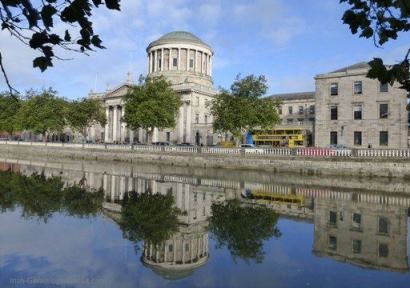
Public Records Office (PRO), Dublin
My next stop was the Public Record Office (PRO) in the Four Courts in Dublin. I needed to look at the Tithe Applotment book for Annaghdown Parish which was kept there. This record of land ownership was done for Annaghdown in April 1826, so it would give information about conditions 30 years before Griffith’s. And again a John Robinson was listed, this time as leasing two parcels of 20 acres each in “Sleivefix”. 1
If this was the same John Robinson, then he had lived in Annaghdown this whole time. Possibly this John Robinson was the father of James Robinson, my ancestor, since he was living in Annaghdown about the time my James was born in 1830. The place name of the lease site I wrote down as “Sleivefix” but it was difficult to read because it was handwritten. I was unaware of the importance this would play later.

1921 fire at Public Records Office, Dublin
The following day I went back to the National Library to look through the parish records for Lackagh. But again I found no Robinsons. I was starting to suspect that the Robinsons were not Catholic at all. The name Robinson was and is an uncommon name in Ireland and was of English origin, so the family could very well have been members of the Church of Ireland (Protestant). Unfortunately most of the Protestant records were destroyed in a fire in the Public Records Office in 1922. However, I did find mention of a few of the Annaghdown records being saved in “a safe in Tuam Cathedral Vestry” which I made a note to check when I got to County Galway.

Rubbish on Moore Street, Dublin, during 1986 Dublin Corporation Bin Workers strike
The rest of that Saturday I walked around Dublin getting the feel of the city, but I was not too impressed, even taking into account a major garbage strike. Dublin gave me the impression of a little town trying too hard to be like London. Still it was interesting to see it.

Sunday I took the bus to Galway. I was fascinated by the countryside. The major highway connecting Dublin to Galway was more like a country road. The roadside was broken up by small farms with rock walls all around. In one field there would be cows and in the next sheep, on and on. This was very different from anything I had seen in America or Europe.
When I got to Galway, I rented a bicycle and loaded its panniers with my camping gear. I asked the direction to Annaghdown and took off. I should mention that I had spent the whole previous year living in London, tooling all over the London area on my bicycle. I had gotten into good enough shape that I had about a 40-mile radius from London to explore, meaning 80 miles a day was no sweat.
The area was beautiful for cycling as the roads were wide and flat, with few drivers and short distances between the places I was going to. It was an ideal way to get around. The countryside was filled with colors I had never seen before, certain pastel shades of blue in the sky and golden brown in the fields that were much more like an impressionist painting than reality. The weather was much milder than England or even Dublin, receiving the full benefits of the Gulf Stream.

After an hour of cycling (about 11 miles), I arrived at Annaghdown. The first thing I saw was the ruins of a 12th-century priory and cathedral and I thought, whoa, that’s all that’s left of Annaghdown! The ruins were interesting yet like so many Catholic churches and priories that I had seen in England that had been destroyed during the reign of Henry VIII. What made them fascinating to me was the thought that my great-great-great grandfather would have seen them, attended church and possibly been baptized here. I took pictures of them all so I could share the images with my American Irish. There was a nearby cemetery and I proceeded to look at every tombstone, but alas I found no Robinsons.

I headed down the road a little farther and found some modern buildings. It wasn’t quite a village of the English variety but rather an attractive group of houses lying along Annaghdown Bay, an inlet of Lough Corrib. There was an interesting memorial there to 20 people who had drowned in an 1828 boating accident.
I went to the modern church in Annaghdown (St. Brendan’s Church by the Lake) but the priest was not in. I asked somebody where the Protestant church was and they looked at me strangely and said there wasn’t one. I couldn’t understand why they looked at me so funny and would not until later in Tuam (pron. CHOOM). As it turned out, I had a lot to learn about the status of the Protestant church in the Republic of Ireland.
I was giving up looking for Catholic Robinsons. Now I needed to find a knowledgeable person to tell me where the Annaghdown Protestant church and cemetery were. I knew there must be a church somewhere because I had found a book at the PRO by Lewis called “Topographical Dictionary of Ireland” published in 1837 which described the church as “a small neat building for the erection of which the late Board of First Fruits gave £500 in 1798.” I could almost picture it as one of those little Georgian English churches of which I had seen so many. Why didn’t anybody know where it was?
I headed off toward Lackaghbeg where I thought the Robinsons might have also lived, hoping to see the Protestant church along the way. Along the way I passed another Catholic church, the Corrandulla Church put I had no idea how it fit in the picture. I thought it was too new and too far away from Annaghdown to play any role in my Robinson story.

After 11 miles of pedaling from Annaghdown, I finally reached Lackaghbeg. I saw some people looking through the Catholic cemetery and I did as well, but still I found no Robinsons. The Lackaghbeg parish priest was, like the Annaghdown priest, not in and the housekeeper didn’t know anything about a Protestant church either. I decided to head back to Annaghdown to see if I could find that priest now.
Out in front of the Corrandulla church, I stopped to eat dinner. I asked a lady coming out of the church where I might get some water and she invited me into her house. Inside I met her husband and they introduced themselves as Andrew and Nora Hennelly. They fed me and offered their barn as a sleeping place, which I gladly accepted. I spent the rest of the night talking to them about what I was doing. At last I had discovered the way to meet the Irish — just go up and talk to them!
I found in talking with the Hennellys that I didn’t have a good sense of Annaghdown parish. I kept thinking it was the area in and around the place on the modern road map that was called Annaghdown, the little hamlet by Lake Corrib. Actually there is the Hennelly’s kitchen we were in Annaghdown Parish. Indeed, Corrandulla Church, officially St. Brendan’s Church Corrandulla, was the main church for Annaghdown Parish, not St. Brendan’s Church by the Lake.

But parishes in Ireland weren’t just Roman Catholic parishes. Annaghdown was also the name of the “civil parish” which was a political subdivision of County Galway. It also was the name historically of the Church of Ireland parish in this area although there was no more official Church of Ireland presence in Annaghdown. Andrew told me that there had been a Protestant church but it had been torn down a long time ago. He assured me that there was nothing left to see and walked me out of his house to show me the right-of-way path that the English soldiers used to walk from their barracks to the church.

Civil Parish of Annaghdown
So when James Robinson in his obituary was reported to have been “a native of the parish of Annadown”, Annadown could have represented any one (or more) of those three meanings of parish. To me that added more fuel to the suspicion that the Robinsons were not Roman Catholic. So the question was, where in this civil parish called Annaghdown did James Robinson live?
I was surprised at how worldly the Hennellys were despite their living in a very rural area. They told me that hadn’t lived all their lives in Annaghdown. They said they also watched a lot of television, but Andrew complained that the television was destroying the art of conversation. Showing my ignorance of modern Ireland, I also asked him why everybody spoke English here instead of Irish; he told me that the last generation to speak Irish was his father’s and Andrew was in his eighties. I certainly did enjoy talking to them and to top it all off I had a very nice sleep in their hayloft.
The next morning (Monday) I got up early to cycle the 13 miles to the Protestant Tuam Cathedral (also known as St. Mary’s Cathedral) to see what records were in the vestry safe.
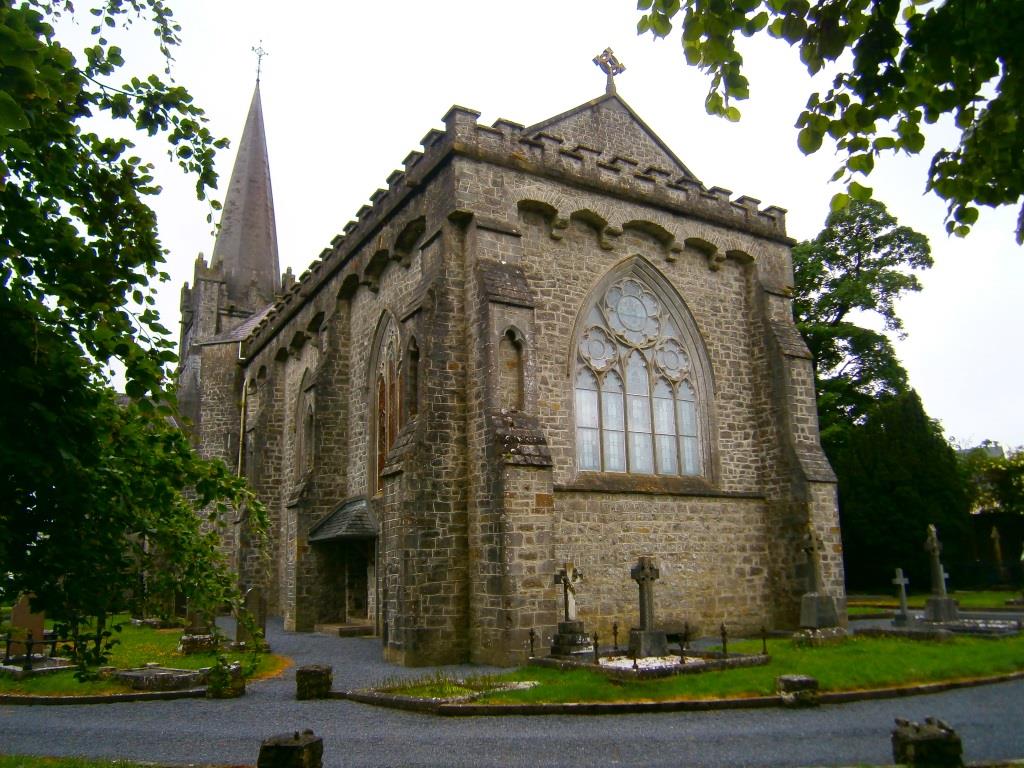
The Synod Hall of St. Mary’s Cathedral, Tuam
When I got to the Tuam Cathedral, I was shocked to discover the condition of this magnificent building. What should have been regarded as a magnificent Gothic revival cathedral was, instead, shut up like a condemned tenement building, busted windows everywhere. I mean this wasn’t just some common church. It was a cathedral!
It was then I realized the state of the Church of Ireland church here. There were no Protestants and what few there were could never support such buildings by themselves. It seemed to me that the Church of Ireland should have given the Cathedral back to the Catholics (since they had taken it from them in the first place after the times of Henry VIII), but the Catholics built there own magnificent cathedral in the late 1800’s in Tuam. So nobody wanted the old St. Mary’s Cathedral.
Despite the gloomy prospects of St. Mary’s Cathedral in 1986, I looked through the tombstones in the Protestant Tuam Cathedral cemetery but could find no Robinsons.
I had trouble finding anyone around who could tell me about vestry records so I headed over to the nearby Roman Catholic Cathedral of the Assumption of the Blessed Virgin Mary in Tuam to see if anyone there knew who to contact. I found a nice priest in the Tuam Parish Centre who gave me the name of Dean Grant in Cong, County Mayo, as the person to contact.
It was a good 22-mile bicycle ride over to Cong, but there I quickly found Dean Grant who oversees the Protestant Diocese of Tuam. He explained to me a bit about the diocese and then sent me across the road to Brigid Clesham who acted as an archivist for the diocese. She was very nice and understanding while her children smeared chocolate all over their faces and the cows nibbled at my panniers. She said she would look into the records for me when she went to Tuam the upcoming weekend.
With that most of my leads were exhausted. I rode the 17 miles back to Corrandulla, hoping to spend another night in the Hennellys’ barn. They were happy to see me again and hear of my adventures. I asked Andrew about the old Protestant church that he had mentioned the night before. I wanted to see where exactly it was, although he assured me that there was nothing there. He drove me down and when we got there, there didn’t seem like much except grass but, as I walked around, I was excited to discover two tombstones that Andrew did not know had existed. One was to a young minister and his wife. The rest of the churchyard had been turned into cow pasture.
As we were driving back, I was talking about the place names I learned from the civil records in Dublin. He had heard of Nineacres, but wasn’t sure where it was. But when I mentioned “Sleivefix”, he immediately popped up with “Slievefin!” (pron. SLEE-fin). We WERE in Slievefin! I had not realized that the names had any importance, thinking they were names like “Happy Acres” which passed away with the present owners. But Andrew informed me that each little area of land had a name which was quite old, and that this land was called a village, even if there was only one or two houses. Immediately he decided to see an old friend of his, Patty O’Brien, who was over ninety. Patty didn’t remember too much more than Andrew, but his son found Nineacres on an old map they had, and it was very close to Slievefin. This area right around the Hennellys and the Corrandulla church was the area where my ancestor probably lived.
The next morning (Tuesday) I went back to the Protestant churchyard-turned-cow-pasture to transcribe the tombstone epitaphs and make sure there were no hidden tombstones. I was convinced that the Robinsons were Protestant since they lived so near the Protestant church. I then went to see another friend of Andrew’s, Willie Killilea, but he was not in. Willie’s sister – after making me sit down and have two helpings of rhubarb pie – told me that John Craven was the man to talk to.
I found John at his home in the middle of some job he was doing and asked him whether he knew anything about Robinsons. He immediately launched into this long story, rattling away about everything he knew about the Robinsons. I slowed him down and started writing down every word he said. The following, as close as I can come to the words of John Craven, is the story of the Robinsons:
Robinson built the first pub in the area, where Fahy’s pub now stands. It was an old thatched two-story pub torn down some ten years ago. Ted Kennedy, the U.S. Senator, had visited the pub and ordered a round for everybody some years back. This Robinson had a daughter Margaret “Peggy” Robinson who married a Mullery [pron. MULL-ry]. They had a daughter Margaret Mullery who married John Kelly. Margaret and John Kelly had three sons James, John and Tommy and a daughter Madge Kelly who married John Craven. Tommy Kelly sold the pub to John Fahy. The Kellys had several other daughters: Tracy Kelly who married Michael Fox; Winnie Kelly who married Joe Kilgarough; and Emily Kelly who married Patrick Furey. In addition, there was another Kelly girl who had a hotel in Prospect Hill, Galway City, called Curran’s. Tracy Kelly’s daughter married John Higgins and lives near Ardgaineen and Emily’s son Patty Joe Furey lives at Corrandulla House and they might know something. He told me he thought the Robinsons came from the Tynagh mine area near Loughrea [pron. Lock-RAY] and that they might be buried in the Cregg [pron. CRAIG] Old Cemetery with the Kellys.
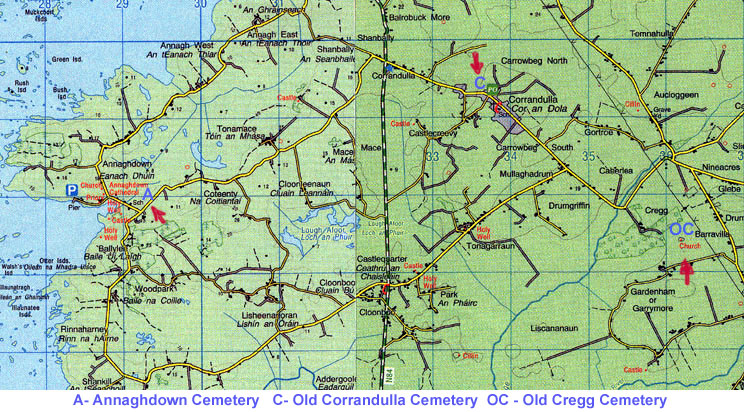
It was difficult to find but I finally discovered it hidden out in the middle of an open field, behind a dilapidated 17th-century mansion called Cregg Castle. The cemetery itself was an old Catholic cemetery, very overgrown with weeds, but with some quite new tombstones, so it was still very much in use.
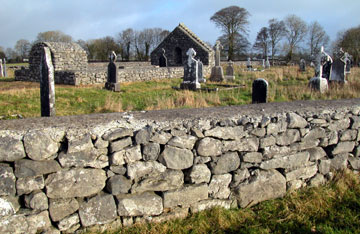
I looked through all of the old tombstones until I finally discovered:
Margaret Kelly who died Nov 15th
1900
Aged 49 yrs.
R.I.P.
Immediately behind this tombstone I found another headstone:
Died FEBRY 14th 1864
Also his wife
Margaret Mullery
Died DECR 25th 1879
R.I.P.
I was disappointed at finding no Robinsons, but now I had some hard cold facts to add to John Craven’s story. I went back to clarify some of the things he told me. Why was Margaret Robinson Mullery buried in a Catholic cemetery? He told me because Robinson was a Catholic. So John Robinson, if he was the father of Margaret, might be Catholic? But could he still be Protestant and his daughter have converted when she married Thomas Mullery? From what I knew this was possible, but it was all still very confusing.
I went in search of Paddy Joe Furey since he lived nearby in Corrandulla House. He answered when I knocked on his door and immediately told me the man I wanted to talk to was Michael Curran who owned Curran’s Hotel on Eyre Square in Galway, that he knew all about the Robinsons. I couldn’t believe it! You mean that somebody knows all about the Robinsons?! He said yes and that he would call Michael to tell him that I would be coming by that evening.
Filled with excitement, I went to see Peggy Fox Higgins in Ardgaineen. When I met her, she seemed interested in what I was doing and she knew something about the Robinsons and Mullerys. She agreed with the family tree that John Craven had given me but said that she was told by her mother that the Robinsons were all Protestants! This was getting even more confusing.
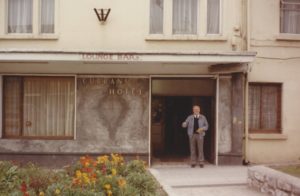
Michael Curran standing in front of his hotel in Galway City June 1986
I rode all the way back to Galway where my bicycle trip started and met Michael Curran at his hotel. He seemed very excited about meeting me, saying that he had been waiting 40 years for me to show up. It seems right after World War II he got interested in his roots and went to his aunts who knew the whole story. A short time later, a couple of GIs walked into Kelly’s pub (the pub that Robinson had built was for most of its life called Kelly’s) wanting to see the pine board ceiling built by their great-grandfather. Johnny Kelly and Patty Joe Furey showed them the ceiling and then showed them the door, without telling Michael, who was needless to say very upset. And Michael Curran has had to wait another 40 years for someone else to show up.
Michael immediately took me to his home where he had an etching of the exterior of the old pub done by the noted artist Bernard Reynolds (which unfortunately I never got a photo or copy of). He told me the original bar-cum-farmhouse was built by John Robinson in 1825/26. He said apparently Robinson was quite a craftsman and the pub was famous for its pine board ceiling and dovetailing. The building was demolished in a road widening scheme in the late 1970’s and was replaced by a single-story building further back on the site.
All of his information came independently from his two aunts: Sister Julia Kelly, a Little Sister of the Poor (a religious order); and Mrs. Ann Kelly Morriss, both born in the early 1880’s. All of their information matched perfectly. Aunt Ann had read all of the old letters that had been sent from America (that sadly seemed to have been lost over the years). Michael said Aunt Ann used to live through those letters because tending a country pub was a very boring life. According to his aunts, Robinson sold the pub to his daughter Margaret “Peggy” Robinson for £300 which paid for the passage of himself and Margaret Robinson’s brother to New Orleans. That would have been quite a lot of money in those days, easily enough to cover passage and allow enough to establish themselves in America.
The most interesting part was that the place they chose to go to was New Orleans. John Craven had told me New Orleans was called the “Irishman’s graveyard” because so many died from tropical diseases. Why would they voluntarily choose to go to the “Irishman’s graveyard”? But the unlikely coincidence that Michael’s Robinsons went to New Orleans from Annaghdown and my Robinsons came to New Orleans from Annaghdown was strong evidence that we were working with the same family.
For Michael Curran what had held his interest these last 40 years is the story that Margaret Robinson had two brothers who became priests and died young. Both had plaques put up in the churches where they last served: one to Father William Robinson in Kilmilkin (Kilmeelickin) Parish, Connemara, County Galway and the other one to Father Robert Robinson in Menlough (pron. MEN-law) Parish on the other side of County Galway. Michael had been out to see these plaques several years ago and found them exactly where his aunts said they were. The next day we would drive out to see these plaques and take pictures of them.
I told Michael that this story added more to my confusion. Why couldn’t I find any reference to Robinson in the Catholic registers for Annaghdown parish if the Robinsons were such good Catholics to have priests in the family? And also why had Peggy Fox Higgins’ mother told her that the Robinsons were all Protestants? Michael couldn’t believe that Peggy thought the Robinsons were Protestants. I asked wouldn’t the story that there were priests in the family that died during the famine years be like having saints in the family? I think Michael does look on them as saints. Why then would another member of the family not even think they were Catholics?
Michael had an explanation. It seems that one of the younger Kelly boys, John Kelly, had been so stirred up by these stories of his older sisters about the priests that he decided to become a priest himself, in which pursuit he was greatly encouraged by his older sisters. However, for some reason or another – after going off for training in Louvain, Belgium – he came home a “failed priest”. Now in Ireland, the stigma of having a failed priest in the family is almost enough to negate having a “saint” in the family. John never married and lived at the pub all his life, a broken man. The younger Kelly girls, including Peggy Fox Higgins’ mother, never forgave the older sisters for pushing John into becoming a priest, which he was just not cut out for. So Michael figures they told their children that the Robinsons were Protestants as revenge against their older sisters.

The next day I got up before everybody else after spending the night in Curran’s Hotel as Michael’s guest. I walked all over Galway which I found very pleasant after Dublin. The old town is filled with cobblestone streets and old buildings. It could have been lifted from Paris, but was definitely an old port town with an international flavor.
 After breakfast, Michael and I headed out to Kilmilkin (also spelled Kilmeelickin), which is in the rugged Connemara part of County Galway. Along the way we talked about other things that Michael remembered or had thought about. The pub was actually built in Aucloggeen, not Slievefin or Nineacres, although these places were close by. The pub was built at the crossroads of six roads. The main road from Galway to Headford ran right past the pub. The area was subject to extreme flooding. In fact, Aucloggeen (Aughlogeen, Aughclogeen, Aughelogun) comes from the Irish Ath Cloigín meaning “ford of the little bell”. Michael thought that it was a place where people forded or ferried across the river and ferries had bells associated with them (presumably to call the ferryman). Thus “bell ford”. Later there was a bridge and presently there is a 3 or 4 arch bridge across the river.
After breakfast, Michael and I headed out to Kilmilkin (also spelled Kilmeelickin), which is in the rugged Connemara part of County Galway. Along the way we talked about other things that Michael remembered or had thought about. The pub was actually built in Aucloggeen, not Slievefin or Nineacres, although these places were close by. The pub was built at the crossroads of six roads. The main road from Galway to Headford ran right past the pub. The area was subject to extreme flooding. In fact, Aucloggeen (Aughlogeen, Aughclogeen, Aughelogun) comes from the Irish Ath Cloigín meaning “ford of the little bell”. Michael thought that it was a place where people forded or ferried across the river and ferries had bells associated with them (presumably to call the ferryman). Thus “bell ford”. Later there was a bridge and presently there is a 3 or 4 arch bridge across the river.
Michael also remembered that the brother of Margaret Robinson was supposed to be studying to become a veterinary. One reason why the priests may have died early was that tuberculosis ran in the family, although Michael always wanted to know if the priests caught sick while tending after the sick in their parish during the famine. Michael’s aunt had told him she first heard of the plaque in Kilmilkin when a man from the area came into the pub and mentioned it.

And like John Craven, Michael had also thought that the Robinsons might have come from the Tynagh area. He had always been curious about having an ancestor Robinson because there were no Robinsons in Annaghdown parish now. He figured they may have come from Tynagh because there are Robinsons over there. When I told him I had noticed some Robinsons in Griffith’s from Tynagh who were caretakers to Earl Clancarty, he said he was afraid that the Robinsons might have been servants to earls and that was not the sort of thing to dig too deeply into in County Galway. It was not the kind of information he would necessarily want to know and thus he had not looked too deeply into the origins of the Robinsons.
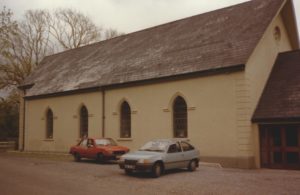
Kilmilkin Church with Michael Curran sitting in his car in front. The plaque to William Robinson is on a low outside wall off to the right. June 1986
When we finally arrived at the little church in Kilmilkin, Michael showed me that the plaque had been moved from inside the church to a low spot on an outer wall. The beautiful black marble had subsequently discolored and it did not look black or like marble anymore.
We shaded in the letters with some chalk that Michael had remembered to bring and took a couple of pictures of the plaque. It read:
The C.C. following his name is an abbreviation for “Catholic Curate.” The curate was something akin to the assistant to the parish priest.
Michael and I then went in search of the parish priest, Father Costello, who lived in Leenaun [pron. lee-NAN]. Michael dropped me off in front of the priest’s house while he went off driving. I learned that the Irish have a very respectful view of their priests and would not in general think of asking them for such information as I was asking. They would be afraid to be so brash as I was and the priests would be taken aback if they acted so. But an American can get away with it because they don’t know any better. And in the end, Michael thought it was all right because it helped both of us get the answers.
Interestingly enough, when I asked Father Costello whether he knew anything about the William Robinson plaque at Kilmilkin, he said he didn’t. But he piped right up with “Is he related to the Father Robinson who has a plaque in Menlough?” I couldn’t believe he knew of the other plaque in a small village on the other side of Galway, but apparently he had been a young priest over there many years ago and had been fascinated with the plaque to the young priest who died during the famine years. (Actually, as we will see, while William Robinson died in 1849 which is still considered part of “the famine years” of 1845-49, the other Father Robinson died in 1842, well before.)
We drove back to Galway and while Michael attended to some work, I went off to the Galway library to check out the historical archives. I went straight to Griffith’s to look at the properties in Aucloggeen that I had not noticed before. Lo and behold right at Number 1 was John Robinson listed as leasing 14 acres from Pierce Joyce with a rateable annual valuation of 3£15s.
Apparently I must not have understood the index in Dublin because I completely missed it in my first search. And what’s more, among 15 or so other tenants at another site in Aucloggeen, again leased from Pierce Joyce, was John Robinson, shown leasing a house, office & garden for a total of 3£15s. There were no other buildings rated so highly except the church (undoubtedly the old Protestant church in Aucloggeen whose abandoned churchyard I mentioned before) also rated at 3£15s. The next most rated building was 1£15s. This “house” or “office” must be the pub! What other kind of building would be rated so high? And from all that I’ve heard and seen, the pub was a very substantial building, easily as substantial as most of the old churches.
So now I had strong evidence linking John Robinson to the pub, but I had another dilemma with Michael’s story. If this John Robinson in Aucloggeen in 1855 (when Griffith’s was done) was the father of my James and went with James to the United States, there was a problem with timing. I hadn’t done much research on my Robinson family in the United States and I had not determined when exactly James had arrived in America. But I did know that James’s oldest son, William, was 14 years old in the 1870 United States census, born in Louisiana, which would suggest James couldn’t have left Ireland later than 1856. (I would later learn William was actually born in Texas.) So if father John was still operating a pub in Aucloggeen in 1855 that would have made it difficult for him to sell the pub and emigrate to America with James in time for James to get married and have a son in 1856.
At the Galway library I was able to take a look at an old map of the area called the “Townland Survey of the County of Galway surveyed in 1839”. For the first time I got a good picture of the area I had been riding my bicycle through for the last three days. I could see where the pub was built at the junction of quite a few roads at the “Source” of Cregg River. The area was all supposed to be swamp before Robinson drained it and built his pub. In fact the map still indicated that the area was “Liable to Floods”. There was also indicated a “Pound” and “Police Barracks” and a cluster of other buildings near the same junction.
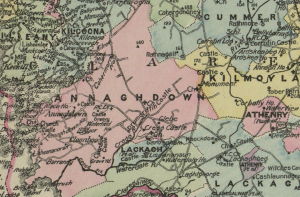
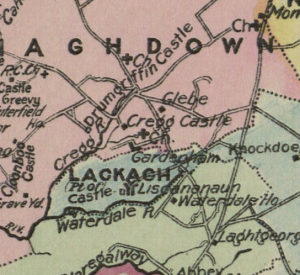
With less detail but perhaps more clarity, a 1901 map shows Aucloggeen where the six roads intersect at the source of the Cregg River, south of the Aucloggeen Protestant church (top center) on the main Galway-Headford road, east of Corrandulla R. C. church (upper left), and north of Cregg Castle and the Old Cregg Cemetery (where the Church is marked due south of Cregg Castle).
One last thing I remember about visiting the local history library was that, as I was walking back into town and about to cross the bridge into the city, a van swerved near me and honked its horn. I looked and there was a couple of librarians holding up my camera which I had left in the library. All those precious pictures! I was certainly lucky to have such nice librarians!

I next stopped at St. Nicholas Collegiate Church, a magnificent 14th-century Protestant church which was as large as, if not larger than, Tuam Cathedral. Apparently Galway had always been a center for Protestants and their congregation was still strong. I was not yet giving up my Protestant search until I found a Catholic record with Robinsons. I went through the tombstones and asked the lady in charge about records. She took my name and information and said she would have someone look for me.
I met Michael at the hotel and we went out to see the other plaque in Menlough. We had quite a time trying to find the right church. In fact we went all through one church trying to find the plaque and gave up, figuring it had been moved elsewhere. I talked Michael into finding the parish priest and when we talked to him we found we had the wrong church. Well all of those old Catholic churches look the same anyway!

We finally found the church in Menlough and the plaque was in its original position. This one did look like black marble and quite shiny so I took the picture at an angle with a flash so there wouldn’t be too much reflection.
The plaque reads:We thought the priest’s name “I. I. Noon” was rather strange. What could it be? Ignatius Ignatius? I wanted to find the parish priest to see if he knew anything but Michael wouldn’t hear of it because it was getting too late. So instead we went to the local pub to talk to the lady in charge. We had a Guinness and then asked her if she knew anything about the plaque and who this I. I. Noon was. She didn’t know anything about that, but she said the man to see was the local school teacher, Mr. Mitchell, who knew everything.
I talked Michael into seeing him because it was our last shot for a while and I was going back tomorrow. So he agreed and we went to Mr. Mitchell’s house. He didn’t profess to know much but he ended up knowing quite a bit about the elements in our search. He was familiar with the area around Aucloggeen and the old pub. I guess Galway history was his main outside interest. He told us about the Revd. John J. Noon (I forgot that people used to write J’s with no bottom loop so you couldn’t tell the difference between J and I) who was buried beneath the altar. He also told us the young priest’s name was Edward (thus the initial E).
So his name wasn’t Robert, as Michael had originally told me, but rather Edward. At first this didn’t strike me as so important but on the drive back to Galway I remembered that James Robinson, the emigrant, named his first-born child in America William Edward Robinson. In fact, there were quite a few William Edward’s in the Robinson tree in America. This is very significant since normally a man in those days would name his first born male after his father or himself. But the child was not named John or James (as later children would be) but William Edward after his two dead brothers whom he would have idolized. While strictly circumstantial, this was one more clue that we were working with the same family.
Mr. Mitchell also remembered that this Edward was supposed to have died shortly after returning from a trip to the United States to collect funds for two schools that were being built in Menlough and possibly died of tuberculosis. Michael seemed to think this was quite possible as tuberculosis ran in the family. We also discussed that Edward might have visited Louisiana and that the Robinsons probably knew people in Louisiana because rarely did people emigrate to a place where they knew no one.
We also talked about the plaque itself. Michael had always thought that these had been paid for by money from America because of the cost involved. However, Mr. Mitchell said that such a plaque would not have cost much (labor being so cheap), but he was not sure that black marble was being cut anywhere in Ireland. Thus it might have had to be imported which would have cost quite a bit. The fact that both plaques were of black marble (and so few other plaques are of black marble) suggests there may be a common origin. However, the misspelling of “ROBBINSON” indicates this plaque was done by a different workman than the one who did the Kilmilkin plaque.
Mr. Mitchell also suggested we check with the Franciscan monastery in Galway to see if their records show any Robinsons from Aucloggeen. In those days all new priests had to be trained outside of Ireland because English law prohibited ordination of priests. Many from Galway were trained in Franciscan monasteries, particularly the one in Louvain, Belgium. Michael had mentioned that his Uncle John had been trained in Louvain. If they were from Annaghdown Parish then most likely there would be records of them in Galway. It would also be a good idea to check the Catholic records for the Diocese of Tuam in Tuam.
Another thing discussed was how Robinson could have shown up in the 1855 Griffith’s if he was supposed to have sold his pub and been on his way to America. Mr. Mitchell told us that Griffith’s took several years to compile and the 1855 date is misleading because the data could have been recorded as early as 1850.
We also talked about such things as the logistics of getting the Guinness (the only ale in Ireland at the time) out to the pub in Aucloggeen. This man was the right kind of person to put all of these facts into a proper perspective, although we ended up with more questions than when we started. We could have talked all night, but we had to go. Mr. Mitchell said he would get back in touch with Michael at the hotel.
One last thing we had to do was to make a xerox of the Administration of the Estate of Thomas Mullery that Michael had in his possession. This stated that he was “late of Aucloggeen in the County of Galway. Farmer and Publican” who died “in or about the month of February 1874” granting all of his goods to “Margaret Kelly (wife of John Kelly) of Aucloggeen aforesaid (Drumgriffin) the lawful daughter and only next of kin,” proved the 12th of June 1890. The death date here 1874 is different from what I copied from the tombstone (1864) although both say February – my mistake or theirs? And why they took so long to prove his estate I have no idea. Maybe the question of ownership never came up until 1890.

The next day I said goodbye to Michael and his wife after they gave me one last Irish breakfast of eggs, ham, sausages, toast, jam, butter and tea with milk.
When I got back to Dublin, I went straightaway to the PRO to look at the Protestant records of the Parish of Loughrea (from where John Craven thought the Robinson might have come), whose registers had been saved from 1808 for baptisms and 1819 for marriages and burials. Protestant records, when they exist, are a lot fuller than Catholic records, listing such things as profession and place of residence. They are also written a lot more clearly. The only mention of a Robinson I found was (1) the baptism of Mary Anne, daughter of Samuel and Mary Anne Robinson, living in Shangarry, profession farmer on August 12, 1823; and (2) the baptism of Sarah Robinson, dau. of Thomas and Sarah Robinson of the Loughrea Military Barracks, a Private in the 2nd Scots Greys, on Sept. 17, 1848. No Robinsons early enough to be ancestors of the Annaghdown Robinsons.
While at the PRO I also checked the Tithe Applotment records of 1826 to see who was leasing the Aucloggeen site then. The whole site was being leased by “Murphy, Burke, Silk and Partners”. It was hard to tell if there was a pub there or not at the time but, if Robinson built it, then the pub would have had to have been built after 1826 since he was not leasing the property or buildings in Aucloggeen in 1826.
Next I went back to the National Library to look more closely at all of the Robinsons in County Galway in the Griffith’s Survey to help locate where the Robinsons may have come from. I didn’t get too far on that although I did have luck finding a Thomas Mulry in the Parish of Moylough, County Galway, along with several other Mulrys. In the microfilm of the Vestry book of Moylough Parish, I found a reference to a Peggy Mullery as a sponsor to a baptism on February 14th, 1852. This Peggy could have been Margaret “Peggy” Robinson Mullery even though I did not find a record of a baptism for her daughter Margaret in either Annaghdown or Moylough parishes.
I could have kept looking at microfilm to find mentions of any of these names that I had learned about but I just couldn’t concentrate any more. My mind was so blown by all of the experiences of the past week, and the speed with which they took place, that I couldn’t keep my mind on my work. I mean I had come to Ireland literally with only an obituary and almost a complete ignorance of Ireland and in less than a week I had found my cousins.
While I was starting to pack up to leave, as fortune would have it, a young woman came up to me and asked me if I was American. She said she was writing an article for a Boston newspaper about the pitfalls of searching for Irish roots. I told her “Have I got a story for you! But it’s not at all typical, because it’s a success story!” I gave her a condensed version of the above story. I don’t know if she ever reported on any of my story.
I left the National Library and started walking around Dublin again. I liked Dublin a lot more this time around because I had been there before and knew my way around and now I knew a bit more about Ireland. I felt more at home now. The garbage strike didn’t bother me anymore.
After I returned to the United States I received two letters from Ireland. One from Brigid Clesham, archivist of the Protestant Diocese of Tuam, saying that she could find no Robinsons in the Protestant records for Annaghdown but that she would keep a look out in the future. The other was from St. Nicholas Collegiate Church, the Protestant church in Galway, reporting they had found two Robinson baptisms:
Sunday Nov. 24th 1816 – Baptized Margaret, daughter of John Robinson – an Instrument Maker – by John Campbell, Vicar.
Feb. 8th 1827 – Baptism of John Robinson.
The first baptism has the right names and the approximate right date for the baptism of Margaret “Peggy” Robinson Mullery. But somehow I can’t imagine our John Robinson went from being an instrument maker to a master carpenter and publican. However, I’ll keep this Protestant John Robinson in Galway in the back of my mind until I find a written record that the Robinsons of Annaghdown were Catholic.
But even without hard evidence the story that Michael Curran learned from his aunts seems to be pretty factual. The fact that Michael’s story matches with John Craven’s account and with all of my research and circumstantial evidence makes a strong case. We haven’t found anything to disprove the story; we just haven’t found enough evidence to prove it beyond a shadow of a doubt. Maybe the evidence does not exist. Or else it is just difficult to find.
There still is quite a bit of more work to do. I think firstly the Franciscans in Galway should be checked to see if there are any records of two priests William and Edward Robinson. The Tuam records should likewise be checked. Also a more thorough search of the records of Annaghdown and Lackagh parish registers must be made to find the name Robinson. To help fit further the pieces of the Irish puzzle, a search of all Robinsons and Mullerys listed in Griffith’s in County Galway should be made; their appropriate parish registers, Protestant and Catholic, should then be searched, particularly in Tynagh and Moylough. The records in Menlough and Kilmilkin should also be checked for mention of the Robinson priests. Finally, all of the other old timers and local historians should be checked to see if any of them remember anything about the origins of the pub and the Robinson who built it.
On the American side, some effort should be made to find a passenger list with the names John and James Robinson with the right approximate ages. There should also be some record of Edward Robinson visiting the United States in 1842. Hopefully a naturalization record on James Robinson can be found (probably in New Orleans) which will show the year of immigration. Probably many clues will be revealed by searching the military records in Washington, D.C. to determine where James enlisted (since he was listed as a sergeant at Fort St. Philip in Plaquemines Parish, Louisiana in 1868). We need to determine whether they came immediately to New Orleans or whether they came via another port like New York City. (And what is that reference to the New York Herald in James’ obituary?) Undoubtedly a more thorough search of Plaquemines Parish civil and church records is called for. A search into the records of his children may also reveal information about their place of birth, etc. Hopefully something will be revealed about the origins of Mary Burke, the wife of James Robinson. Was she one of the many Mary Burkes of Annaghdown Parish? Also all of the descendants of James Robinson who are still living must be contacted to see if any stories have been passed down on this side of the Atlantic. And who were the two servicemen, possibly descendants of John Robinson, who visited Aucloggeen immediately after the war? If they were indeed descendants of John Robinson, there couldn’t be too many people who fit that category.
Obviously a lot of work still needs to be done. And of course for every answer there will be two new questions. Thus the “true” story of John Robinson and his children may never be known. But what we do know makes quite a story. And hopefully it will lead to a closer understanding of our roots and our family over the seas. Attached is the story of John Robinson as best I know.
* * *
JOHN ROBINSON
of Annaghdown Parish, County Galway, Ireland
John Robinson, the ancestor of all of the Robinsons of Annaghdown Parish, County Galway, Ireland, moved there before 1826 and possibly before 1814 when his first child was born. He is said to have come from the Tynagh mine area of County Galway near Loughrea. We do not know the name of his wife. His children include: William born 1814, Margaret 1817, Edward 1818, and James much later in 1830. There probably were other children, including a son named John (nicknamed Thady), but we don’t know much about them. After moving to Annaghdown parish, he first lived in Slievefin and then, sometime after 1826, leased some land in Aucloggeen where he built a two-story, thatched roof pub with a fine pine board ceiling.
The two oldest boys, William and Edward, trained to be priests and probably were educated in Louvain, Belgium. On 18 March 1842, Edward died at the young age of 24 years, possibly of tuberculosis. He was only three months out of the seminary and had just returned from a trip to the United States to collect funds for the building of two new schools in Menlough Parish. He was buried in Menlough Parish church and a plaque of black marble was put up in his honor by Reverend John J. Noon, P.P. Killescobe. In 1846 the Irish potato famine started and all of County Galway was hit pretty hard. In 1849 William died in Kilmilkin Parish at the age of 35. He was buried beneath the altar of Kilmilkin Parish church and a black marble plaque was put up in his honor as well. Probably about the same time Margaret married Thomas Mullery and may have gone off to live in another parish (possibly Moylough Parish).
Around 1855 John the elder decided to sell his pub to his daughter Margaret and her husband in order to move to New Orleans with his youngest son James. James had been studying to become a veterinary, probably in Galway City. He sold the pub for £300 and used this to pay for his son’s and his passage to New Orleans. The two left soon thereafter. We have not yet found a record of this John Robinson in the United States so it is possible that he did not survive the passage or died soon thereafter.
James Robinson married Mary Burke (possibly in Annaghdown Parish) and established himself in Plaquemines Parish, Louisiana, about 75 miles down the Mississippi River from New Orleans, where he had an orange grove. He had four sons: William Edward born 1856 (named after James’s two dead brothers), John 1858 (died young before 1883), James Michael 1861, and Samuel J. 1863. James Robinson died January 14, 1875, in New Orleans, and was buried in Plaquemines Parish, Louisiana.
Thomas and Margaret Mullery had one daughter, Margaret (born 1851), who married John Kelly. Margaret “Peggy” Robinson Mullery died December 25, 1879, and was buried in Old Cregg Cemetery.



